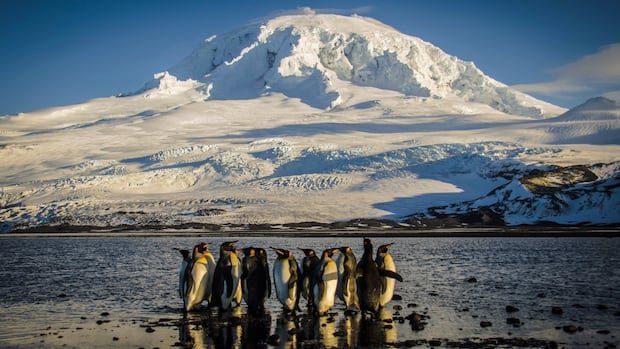‘Tariff the seagulls?’ These are the remote islands on Trump’s tariff list, and what they export

An uninhabited Antarctic outpost populated by penguins. One of the smallest economies in the world. An Arctic archipelago with more polar bears than people.
To quote Australian Prime Minister Anthony Albanese, it really does appear that “nowhere on Earth is safe” from U.S. President Donald Trump’s sweeping tariffs.
Trump rattled markets, manufacturers and more Wednesday announcing a baseline of 10 per cent tariffs on imports into the United States — and far higher on goods from some places, notably those with high trade surpluses with the States. In enforcing his steep and broad tariffs, analysts have suggested Trump has upended the global order.
But to many observers, the most puzzling aspect of Trump’s list was that it included some of the most remote and smallest territories and islands in the world. Places that, in some cases, are largely inhabited by penguins.
Like Australia’s Heard and McDonald Islands in the sub-Antarctic region, one of the most remote places on earth, and which, according to the Australian government website, have only been visited by humans about 242 times since 1855.
“The Heard and McDonald Islands are completely uninhabited. Population zero. I guess we’re going to tariff the seagulls?” wrote Aaron Reichlin-Melnick, a senior fellow at the American Immigration Council, on X.
With that in mind, here are some of those territories, the tariffs they face — and what they actually export.
British Indian Ocean Territory: 10%
The British Indian Ocean Territory is an archipelago of 58 islands covering about 640,000 square kilometres of ocean, about halfway between East Africa and Indonesia.
It’s not a tourist destination. Access is restricted and you need a permit to travel there, according to the territory’s website. It has no permanent population, but about 3,000 U.S. and U.K. military personnel and civilian contractors live on the island of Diego Garcia, according to the CIA Factbook.
Its U.S. imports totalled about $462,500 US in 2024, according to the U.S. Census Bureau. Its top commodities were computer and electronic products, followed by livestock and livestock products.
According to the CIA Factbook, all economic activity is concentrated on Diego Garcia, where “construction projects and various services needed to support the military installation are performed by military and contract employees from the UK, Mauritius, the Philippines, and the US.”
Heard and McDonald Islands: 10%
The Heard and McDonald Islands in the remote Antarctic together form an uninhabited Australian territory. The mostly barren islands between Madagascar and Antarctica have two active volcanoes and can only be reached by sea.
“Due to the extreme isolation… together with the persistently severe weather and sea conditions, human activities in the region have been, and remain, limited,” says the Australian government’s Antarctic program website.
And yet, for reasons not immediately clear, U.S. imports by the uninhabited islands totalled $13,590 US in 2024, according to the U.S. Census Bureau. This mostly consisted of electrical equipment and appliances, computer and electronic programs, and transportation equipment.
A report in The Guardian suggests that some of the data for these islands, and for Norfolk Island, may come from mislabelled shipments.
The CIA Factbook doesn’t list any economic activity for Heard and McDonald Islands, saying they are “populated by a large number of bird species, seals, and penguins,” and that “the islands are primarily used for research, with limited fishing permitted in the surrounding waters.”
U.S. President Donald Trump’s sweeping ‘Liberation Day’ reciprocal tariffs were described as ‘meticulously planned,’ but among the targets are the landlocked African nation of Lesotho, an island home to a U.S. airbase, and Australia’s Heard Island and McDonald Islands — where most residents are penguins.
Norfolk Island: 29%
Norfolk Island in the Pacific, another Australian territory, with a population of around 2,000 people, received more severe tariff treatment.
The Trump administration, in its calculation, says the former British penal colony charges 58 per cent tariffs on the U.S. — and it responded with a tariff of 29 per cent on the island, whose economy revolves around tourism. It’s about 1,600 kilometres east of Sydney.

Norfolk Island Administrator George Plant, the Australian government’s representative there, was looking into it.
“To my knowledge, we do not export anything to the United States,” he told The Associated Press. “We don’t charge tariffs on anything. I can’t think of any non-tariff barriers that would be in place either, so we’re scratching our heads here.”
Their U.S. imports in 2024 totalled around $191,000 US, according to the U.S. Census Bureau. The vast majority of these were under a category called “goods returned,” which is merchandise sent back after it has been imported to the U.S. Otherwise, it was mostly transportation equipment ($25,000 US), and computer and electronic products ($14,770 US).
The CIA Factbook says the territory’s economy is high-income, with key tourism and re-exportation industries.
Norfolk Island, an external territory of Australia in the Pacific Ocean, was hit by 29 per cent tariffs by U.S. President Donald Trump despite having no known exports to the States. Jesse Schiller and Rachel Evans, two Canadians who run a business on the island, explain how they’re reacting to the tariff.
Svalbard and Jan Mayen: 10%
Jan Mayen is a small Arctic island, possibly featuring more polar bears than people. The CIA Factbook describes it as “desolate” and “barren.”
The only inhabitants on Jan Mayen, part of Norway since 1930, are staff of the Norwegian military and the Norwegian Meteorological Institute. The island — 600 kilometres northeast of Iceland — is partly covered by glaciers.

Svalbard is a Norwegian archipelago in the Arctic Ocean. Just under 3,000 people live there, most of them in the world’s northernmost urban community, Longyearbyen, according to the Svalbard tourism website.
The two regions now face 10 per cent tariffs. Their U.S. imports in 2024 totalled just under $42,000 US, according to the U.S. Census Bureau.This largely consisted of non-electrical machinery, followed by computer and electronic products.
According to the CIA Factbook, Svalbard’s economy largely consists of coal mining, tourism and research, a key whaling and fishing base, and is also home to the Global Seed Vault. The factbook doesn’t list anything for Jan Mayen’s economy, saying it has been “visited only occasionally by seal hunters and trappers over the centuries.”

Tokelau: 10%
This nation is made up of three tropical coral islands and is home to 1,500 people on a combined land area of 10 square kilometres.
One of the smallest economies in the South Pacific, Tokelau survives on subsistence agriculture, fishing, and finance from New Zealand, which counts the islands as one of its territories.

Their U.S. imports in 2024 totalled $177,600 US, according to the U.S. Census Bureau. Nearly all of that was under a category called “other special classification provisions,” or items that don’t fit neatly into other categories. The CIA Factbook says the majority of Tokelau’s exports are cars, telephones, garments, iron fasteners and fabric. The U.S. is not listed as one of its major trading partners.
According to the Commonwealth Chamber of Commerce website, Tokelau has one of the smallest economies in the world, and its main sources of revenue are sales of copra (dried coconut products), postage stamps, souvenir coins, handicrafts and remittances from relatives in New Zealand.
Cocos (Keeling) Islands: 10%
Another Australian territory, these 27 coral islands are located in the Indian Ocean between Australia and Indonesia, and make up about 14 square kilometres. Only about 593 people live there, according to the CIA Factbook.
Its economy is largely based on agriculture (such as bananas, pawpaws, and coconuts), tourism and copra products.
For a small set of islands, its U.S. imports were on the larger side at about $1.1 million US, according to the U.S. Census Bureau. The largest category was “goods returned,” followed by computer and electronics products and transportation equipment.
The CIA Factbook says the islands send 31 per cent of its exports — ships — to the U.S.






